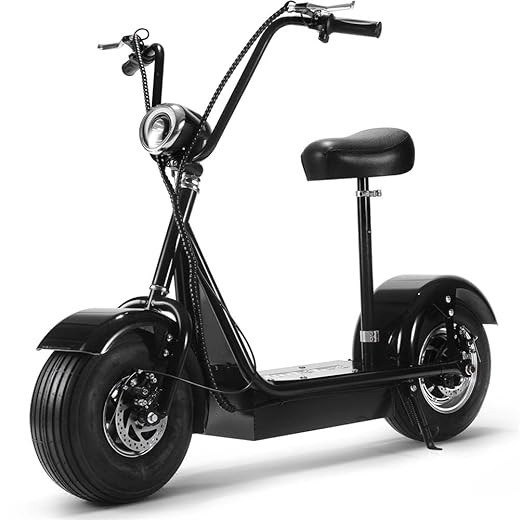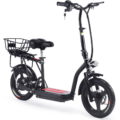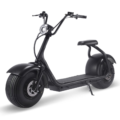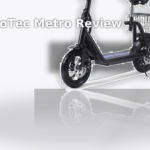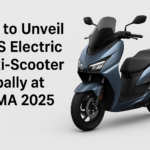- Home
- Scooters
- Electric Scooters
- MotoTec FatBoy
MotoTec FatBoy
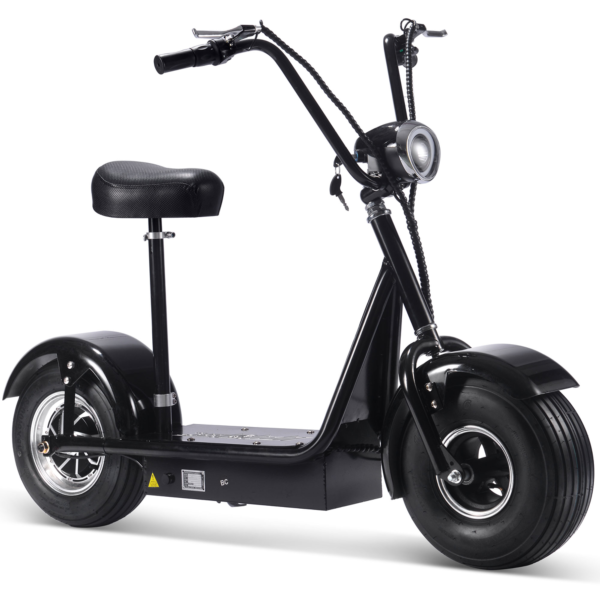

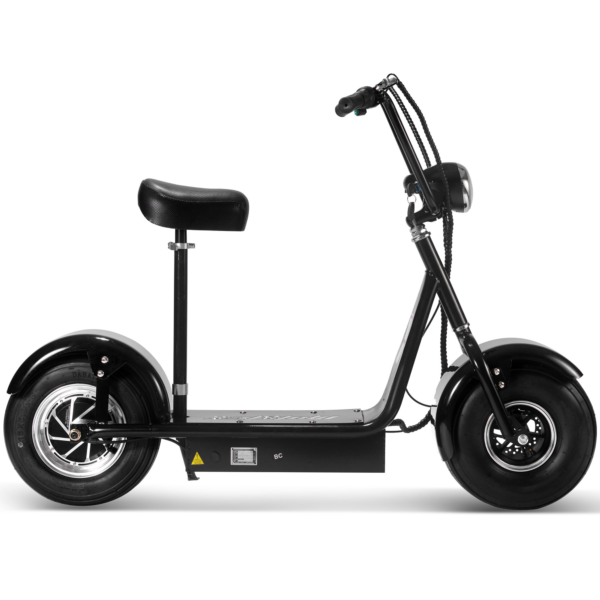
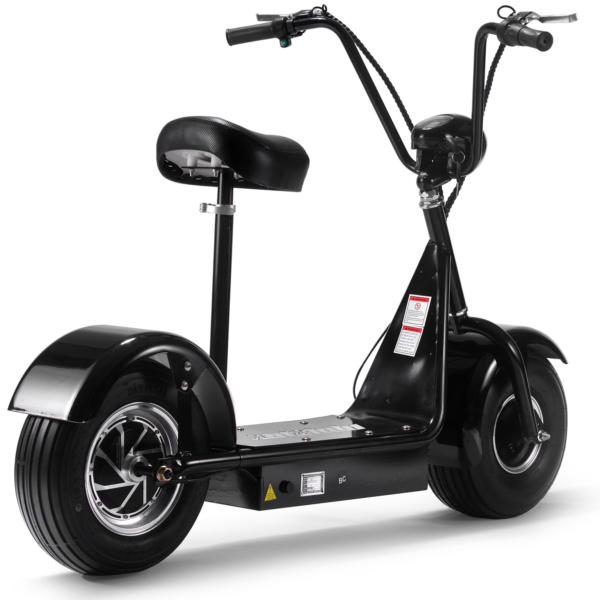
- Battery Range: 5–15 miles (8–24 km)
- Top Speed: 18 mph (29 km/h)
- Motor Power: 800 W
- Weight Capacity: 250 lb (113 kg)
- Charging Time: ~4–8 h
- Scooter Weight: Not specified
PROS
- 800W 48V hub drive
- Selectable 5/10/18 mph speeds
- 15-inch pneumatic tires for stability
- Hydraulic brakes (front & rear)
- Large headlight for visibility
CONS
- Short 5–15 mi range (SLA pack)
- Scooter weight not specified
- No IP rating listed
- No app or smart features
Key Takeaways
- The MotoTec FatBoy is a seated electric scooter designed for comfort with an 800W rear hub motor and 48V battery system.
- It features large 15-inch tires for stability, a removable handlebar for storage, and can support riders up to 250 lb (113 kg).
- Expect a range of 10-20 miles based on riding style, with a charge time of 4-8 hours.
- The scooter emphasizes a smooth ride, making it ideal for short commutes, campus travel, and RV use.
- Though it lacks folding capability, its build quality and ease of maintenance make it a solid choice for casual riders.
Table of contents
- What Is the MotoTec FatBoy?
- How the MotoTec FatBoy Works
- Key Specifications
- Design & Build Quality
- Performance Fundamentals
- Battery, Range & Efficiency
- Ride Quality & Comfort
- Braking & Safety Features
- Portability & Daily Usability
- Maintenance & Care
- Weather & Seasonal Considerations
- MotoTec FatBoy vs Alternatives
- Who the MotoTec FatBoy Is (and Isn’t) For
- FAQs
- Glossary
- Final Notes on Daily Use
- Subtle Trade-offs to Weigh
- Care Checklist (Printable)
- Performance Tips
The MotoTec FatBoy is a fat-tire, seated electric scooter made for easy rides and short trips. It runs a 48-volt system with a rear hub motor, and it rolls on tall 15-inch pneumatic tires that calm cracked pavement. The deck is wide, the bar sits high, and the saddle is soft. So city riders, campus commuters, and RV owners get a steady ride without much fuss.
You want a clear picture and straight talk. So this guide lays out what it is, how it works, and how it behaves day to day.
What Is the MotoTec FatBoy?
The MotoTec FatBoy is a stand-up scooter with a seat and a steel frame. It lives in the “fat-tire cruiser” lane, so comfort and stability come first. The motor sits in the rear wheel, and a 48-volt battery pack hides under the deck. Two hand levers control the disc brakes. Then a key switch brings the system to life. A big headlight helps at dusk.
It supports riders up to 250 lb (113 kg). It is not a quick-fold commuter. But the handlebar comes off with tools for storage, so it fits in a trunk or RV bay with a little prep. The boxed unit weighs 101 lb (45.8 kg), and that matters when you lift it.
So the target is calm travel at neighborhood speeds. Wide bars give leverage, the long wheelbase tracks straight, and the big tires float over seams and small potholes.
How the MotoTec FatBoy Works
Motor. A rear hub motor rated at 800 watts turns the wheel directly. There is no chain and no belt, so the drivetrain stays quiet and simple. You twist the throttle, current flows to the hub, and the motor pushes you forward. It gives a steady shove off the line and a smooth pull as speed rises. For a simple compare of drive types, see hub vs belt vs chain drive with notes on efficiency, noise, and upkeep.
Controller. A compact 48-volt controller meters power. It follows your throttle input and keeps the pack within a safe draw. Then it trims output as the battery nears empty. The feel is steady and predictable rather than sharp and jumpy.
Battery. Power comes from four 12-volt, 12-amp-hour sealed lead-acid batteries wired in series for 48 volts. They sit in a tray beneath the deck, so the center of mass stays low and the scooter feels planted. Treat the pack gently and it will last a good run of cycles.
Throttle and gauge. A twist throttle lives on the bar. A simple gauge shows charge at a glance. Under hard pull the bars drop, then rebound when you coast. That dip is normal for this chemistry, so check state of charge while cruising or after a short rest.
Brakes. Two hand levers work front and rear disc brakes. One finger can shave speed in traffic. A deeper pull brings a firm stop. And using both levers together keeps the scooter straight and shortens stopping distance.
So the system stays simple: key on, twist to go, squeeze to stop. New riders get comfortable fast.
Key Specifications
The table groups the most useful facts for quick reference. Measurements list US units first with metric in parentheses. The word specifications appears where it helps clarity and not more than a few times.
| Category | Details |
|---|---|
| General | Model: MotoTec FatBoy (48V, 800W). Recommended age: 13+. Max rider weight: 250 lb (113 kg). Use: paved paths and streets where legal. |
| Performance & Power | Motor: 800W rear hub. Rated speed: up to 22 mph (35.4 km/h), rider and terrain dependent. Climbing ability: 10° (about 17.6% grade). Drive: direct hub, single speed. |
| Battery, Charging & Electrical | Battery: 48V (4 × 12V, 12Ah sealed lead-acid). Recharge time: 4–8 hours. Cycle life: 250+ charges. Headlight: large front light. Battery gauge: bar-style indicator. |
| Build & Dimensions | Tires: 15×6.00-6 pneumatic (front and rear). Ground clearance: 3 in (7.6 cm). Scooter size: 51 × 11 × 48 in (129.5 × 28 × 122 cm). Folded dimensions: N/A (non-folding; handlebar removable for storage). Box size: 56 × 13 × 28 in (142 × 33 × 71 cm). Box weight: 101 lb (45.8 kg). |
| Safety & Control | Brakes: front and rear hand-operated disc brakes. Cockpit: wide handlebar with key switch and throttle. Lighting: front headlight; add side and rear reflectors for night rides. |
| Features & Extras | Saddle: wide padded seat. Kickstand: side stand. Speed-limiting selector: low to high. Cruise Control: not included. |
| Warranty & Compliance | Age label: not for riders under 13. Water ingress rating: not listed. Warranty: term varies by seller; parts support via authorized channels. Local laws: rules differ by region. |
Note: The bar uses a fixed stem without a quick-fold joint. The removable handlebar helps storage and transport rather than fast multi-modal hops.
Design & Build Quality
The frame is steel and stout. Welds look clean, and the deck is thick metal with a grippy top plate. Motor wiring tucks along the rear arm with strain relief near the axle. Then a cover shields the battery tray from splash and grit.
The handlebar stands tall with a mild sweep, so your elbows relax and your chest stays open. Controls stay simple: a keyed switch, a twist throttle, and two levers. The headlight mounts low on the fork and throws a broad pool of light on the road.
The seat posts off the deck and sets an upright stance. The saddle is wide and soft, so longer rides feel friendly on the lower back. Fit and finish focus on function. Fasteners use common hex sizes, so a small tool roll covers most jobs.
Those big 15-inch tires define the look. The sidewalls are tall and the tread is broad. So the tires add damping many small-wheel scooters lack. Fenders sit close to block spray. And the side stand lands with a solid snap and holds the scooter steady.
Performance Fundamentals
Off the line, the MotoTec FatBoy gives a smooth shove. Speed builds in a straight, predictable way, and traction feels secure on patchy pavement. A large contact patch helps with that, and the long wheelbase keeps the line calm.
Cruising stability stands out. The wide bar and large tires filter small hits, and the chassis resists twitch. On typical streets, most riders settle into a mid-teens pace. Then they tap higher speeds on longer, open stretches when space and sight lines allow.
Hills test every small EV. On 7–10% grades, the FatBoy climbs at a measured pace and holds momentum best with smooth throttle. Speed drops on longer hills, and the gauge sags under load. So plan to crest in a moderate setting rather than chasing peak numbers.
Steering feels light for the size. The tall bar gives leverage in slow turns. And the geometry stays calm in broad sweepers. At higher speeds, keep a relaxed grip and let the front track. The design prefers straight, stable motion.
Battery, Range & Efficiency
The pack uses sealed lead-acid cells rated at 12Ah each. Four in series deliver 48V. This chemistry is sturdy and easy to service. It is heavier than many lithium packs, yet it handles cold fairly well.
Range changes with speed, weight, temperature, and terrain. On flat paths at a steady pace, the rated window sits near 15–20 miles (24–32 km). In mixed traffic with stops, plan for 10–15 miles (16–24 km). So map your loop and leave a buffer for wind and hills.
Charge time lands in the 4–8 hour band from a low pack. A gentle routine helps a lot. So plug in soon after rides, avoid deep drains, and let the charger finish its cycle. For storage, keep the pack topped and indoors.
Cold trims range. Heat ages batteries faster. So park inside when you can and charge at room temperature. The gauge will dip when you accelerate and rebound when you coast. Judge state of charge at a steady cruise or after a short rest.
Ride Quality & Comfort
Big tires do most of the comfort work. The tall sidewalls flex over cracks, seams, and cobbles. So the ride stays calm at city speeds even without spring suspension. At lower pressures, grip rises and chatter falls. At higher pressures, drag drops and steering sharpens. Find a pressure that feels planted in turns and stick with it.
The saddle is broad and supportive. On longer runs, stand on the deck to stretch, then sit again. The bar height suits many riders out of the box. Taller riders can rotate the bar forward for reach, and shorter riders can roll it back.
Stem flex is minimal since there is no folding joint. That solidity boosts confidence on broken pavement and during quick stops. The deck is long enough for a natural stance. You can place both feet forward or shift into a surf stance for extra control in turns.
Noise stays low. The hub hums, and the big tires mute road buzz. So neighborhood loops feel quiet and relaxed where riding is allowed.
Braking & Safety Features
The dual disc brakes offer a clean, linear feel. The bite shows up near mid-pull, and power ramps smoothly from there. Use both levers together for the shortest stop. In traffic, cover the right lever with a finger and add the left as you set up for a halt.
The headlight improves low-light visibility and spreads a broad beam across the lane. For night rides, add side and rear reflectors and clip a tail light to your bag or belt for extra pop.
No formal IP rating is listed. So plan for dry rides. If you meet wet roads, slow down, skip puddles, and dry the scooter when you park. Then check that the brakes feel clean and strong before the next outing.
A key switch adds a basic layer of security. Turn it off whenever you step away. Then lock the frame to a fixed point with a sturdy U-lock or chain.
Portability & Daily Usability
This scooter is heavy and does not fold. So transport plans matter. Ramps help for hatchbacks and vans. The handlebar removes to lower height, and soft straps keep the frame stable while you drive.
At home, the side stand makes parking simple. Pick a dry corner near an outlet. Leave some space around the charger for airflow. Then route the cord so it does not trip anyone.
For errands, the flat deck carries a small bag at your feet. A bar bag holds keys, a lock, and a compact pump. Then a seat-post bottle cage can carry water on warm days.
Security habits make a difference. Lock through the frame, not just a wheel. Then remove clip-on lights or accessories when you leave the scooter at a rack.
Maintenance & Care
A short routine keeps the FatBoy consistent and safe:
- Before each ride: Check tire pressure with a gauge, squeeze both brake levers, and confirm a steady battery readout.
- Weekly: Inspect bolts on the bar clamp, calipers, and fenders. Wipe dust off the deck and battery cover. Then spin the wheels to check for rub.
- Monthly: Top off the tires to your chosen PSI. Re-center calipers if you hear minor rotor rub. Check pad wear for a clean bite.
- Quarterly: Open the battery cover, inspect terminals for corrosion, and snug them gently if needed. Then confirm the controller connectors are fully seated. A touch of dielectric grease helps in humid regions.
So much of the care is inspection and pressure checks. Keep the tires in range and the scooter will ride better, stop shorter, and roll farther.
Weather & Seasonal Considerations
Rain. The FatBoy lists no water rating, so aim for dry rides. If a shower starts, slow down, avoid puddles, and dry the scooter after parking. Then test the brakes for a clean bite before the next ride.
Heat. High heat stresses batteries. Park indoors or in shade, and charge at room temperature. Keep tire pressures within the sidewall range to limit heat buildup.
Cold. Low temps reduce range and harden rubber. Pre-warm the pack indoors. Then ride at a steady pace and brake gently on painted lines and metal plates.
Storage. For the off-season, clean the scooter, charge the pack, and check charge monthly. Top up as needed. Then keep the tires off bare concrete with a mat to reduce moisture transfer.
MotoTec FatBoy vs Alternatives
Against slim-tire commuters, the FatBoy wins on calm ride and straight-line stability. The big rubber filters cracks that jar small wheels, and the upright stance builds confidence for new riders. Care stays simple too.
Against sport scooters, the FatBoy rides slower and weighs more. Sport models sprint harder and climb faster with lighter lithium packs. They often fold for trains and stairs, and they carry less mass overall.
Against off-road stand-ups with knobby tires, the FatBoy favors paved paths. It will roll on a hard-packed lane, yet the cockpit, brakes, and geometry point to urban cruising more than trail work. So pick your surface and plan your route.
In plain terms, the FatBoy excels as a steady cruiser for short trips, casual laps, and RV park loops.
Who the MotoTec FatBoy Is (and Isn’t) For
Great for:
- Short commutes under 8–10 miles (13–16 km) round trip
- Students who want a calm seated ride across campus
- RV travelers who need a packable runabout for the campground
- Riders who value stability over high top speed
- Owners who like simple parts and light service
If you shop for a younger rider, check our best electric scooters for kids roundup for age-appropriate picks.
Not ideal for:
- Multi-modal commuters who need a fast fold for trains or stairs
- Riders who want sharp acceleration and very high speed
- Daily rain riders who need a formal IP rating
- Anyone who must carry a scooter up long flights
So if your routine is a few miles to a café, a lakeside loop, or a glide from RV pad to store and back, the MotoTec FatBoy fits that plan.
FAQs
1) What is the real-world top speed?
On level ground with a lighter rider, expect a steady cruise in the mid-teens and a peak near the low 20s mph (about 35 km/h). Headwinds, hills, and load trim that number.
2) How far can I ride on one charge?
Plan for 10–15 miles (16–24 km) of mixed use with stops and starts. Smooth pacing on flat paths stretches range, and cold shortens it.
3) Can I ride in the rain?
No formal IP rating is listed. So aim for dry rides. If roads are wet, slow down, skip puddles, and dry the scooter afterward.
4) Does the MotoTec FatBoy have cruise control?
No. The control set is simple: key, throttle, brakes, headlight, and a speed-limiting selector.
5) What tire pressure should I run?
Stay within the range on the sidewall. Lower pressures add grip and comfort, and higher pressures reduce drag. Check with a gauge before rides.
6) How often should I service the brakes?
Inspect pad wear monthly. Re-center the calipers if a rotor rubs. Replace pads when the friction layer thins to a few millimeters.
7) Where can I find a concise MotoTec FatBoy overview?
You are reading it now. This guide covers the platform, the core systems, and the key facts riders ask about.
Glossary
- Ah (amp-hours): A measure of battery charge. Higher numbers store more at a given voltage.
- Wh (watt-hours): Battery energy. Multiply voltage by amp-hours.
- Controller: The box that meters power from the battery to the motor.
- Hub motor: A motor inside the wheel hub that turns the wheel directly.
- Torque: The twisting force that gets you moving from a stop.
- Grade (%): Hill steepness as rise over run. Ten degrees is about 17.6%.
- Pneumatic tire: An air-filled tire that cushions bumps and adds grip.
- Regen: Regenerative braking that feeds power back when slowing; the FatBoy relies on discs instead.
- Stem flex: Handlebar post movement under load; less flex feels steadier at speed.
- IP rating: A code for dust and water resistance; none is listed here.
- Lead-acid battery: A sealed battery type used here; sturdy, heavy, and serviceable.
- Voltage sag: A drop in voltage under load that rebounds when you coast.
- Speed limiter: A control that caps speed for training or safety.
- Wheelbase: Distance between axles; longer wheelbases track straighter.
- Ground clearance: Space between the lowest frame point and the ground.
Final Notes on Daily Use
Plan your loop and leave a little reserve. Charge after rides, and keep tire pressure in range. Build a quick pre-ride habit: key on, gauge check, lever squeeze, and pressure check. Those small steps add up to safer rides and steadier range.
The MotoTec FatBoy focuses on calm miles and easy upkeep. The wide tires carry much of the comfort load. The direct hub keeps noise low. And the steel frame adds a solid feel many riders like.
Subtle Trade-offs to Weigh
- Weight vs stability. The heavy frame and big tires ride steady, yet they are harder to carry.
- Lead-acid vs lithium. The pack is simple and sturdy, yet it is heavier and offers less range pound-for-pound.
- Non-folding vs compact storage. The removable bar helps storage, yet there is no quick fold for buses or stairs.
- Speed vs comfort. The scooter favors steady cruising over quick sprints and tight carving.
So match the tool to the job. If you want low-stress miles and easy care for short daily trips, the FatBoy makes a strong case.
Care Checklist (Printable)
- Charge after each ride
- Check tire pressure before rides
- Inspect brake levers and pad wear weekly
- Tighten bar clamp bolts monthly
- Clean and dry after wet roads
- Store indoors with a charged pack
- Inspect battery terminals quarterly
Stick to this list and performance stays consistent across seasons.
Performance Tips
- Start in a lower speed setting while you learn the controls
- Keep a light grip at speed and look far ahead
- Use both brakes for short, straight stops
- Coast into turns, then roll on the throttle as you exit
- Keep cargo low and centered on the deck
- Wear bright gear and add side reflectors for night rides
Small habits build safer miles and fewer surprises.
Specifications
General
| Model The Model specifies the exact version or name of the scooter. It helps identify its unique design, features, and specifications within the manufacturer’s product line. Knowing the model makes it easier to compare options, find compatible accessories, or look up support information. | FatBoy |
| Brand The Brand identifies the manufacturer or company that designs and produces the scooter. A trusted brand is a sign of quality, reliability, and good customer support. Well-known brands often have higher standards for safety, performance, and after-sales service, giving you more confidence in your purchase. | MotoTec |
| Release Date The Release Date indicates when the scooter model was officially launched on the market. This helps you know how current the design, technology, and features are. A newer release date often means updated components, improved performance, and the latest safety or smart features. | 18 November 2025 |
| Recommended Age Recommended Age indicates the minimum age range that the scooter is designed for, based on safety, size, and ease of use. Following the recommended age helps ensure that riders can handle the scooter’s speed, weight, and controls comfortably and safely. Always check local laws and use protective gear, especially for younger riders. | 13+ |
Performance & Power
| Motor Power (Wattage) What it means: The motor power, measured in watts (W), shows how strong the scooter’s electric motor is. Why it matters: Higher wattage usually means better acceleration, more torque, and improved performance on hills or rough terrain. For example, a 250W motor is good for flat city roads and light riders, while a 500W or 1000W motor provides more power for faster speeds or climbing steep inclines. | 800 W 48 V hub motor |
| Top Speed The Top Speed indicates the maximum speed that the scooter can reach under optimal conditions. It’s usually measured on level ground with a fully charged battery and an average rider weight. A higher top speed allows you to travel longer distances faster, but always ensure you ride within legal speed limits and your personal comfort zone for safety. | 18 mph (29 km/h) |
| Battery Capacity Battery Capacity refers to the total amount of energy the scooter’s battery can store, usually measured in ampere-hours (Ah) or watt-hours (Wh). A higher battery capacity means you can ride longer distances on a single charge, reducing the need for frequent recharging. Keep in mind that actual range can vary depending on rider weight, terrain, speed, and weather conditions. | 48 V 12 Ah (≈576 Wh) — sealed lead-acid |
| Estimated Range per Charge The Estimated Range per Charge indicates the average distance the scooter can travel on a single full battery charge. This range is calculated under optimal conditions, such as flat terrain, moderate speed, and average rider weight. Real-world range may vary depending on riding style, terrain, weather, and load. A longer range means fewer recharges and greater freedom for longer trips. | 5–15 miles (8–24 km) |
| Hill Climb Ability Hill Climb Ability describes the maximum incline or slope that the scooter can handle while maintaining stable performance. It’s typically expressed as a percentage or in degrees. A higher hill climb rating means the scooter can tackle steeper hills without losing too much speed or power. Actual climbing performance may vary based on rider weight, battery charge, and terrain conditions. | Up to 10° |
| Drive System The Drive System refers to how power from the motor is delivered to the wheels. Electric scooters typically use either a hub motor (directly integrated into the wheel) or a chain/belt drive system. A high-quality drive system ensures smooth acceleration, efficient power transfer, and low maintenance. The choice of drive system affects performance, noise level, and overall ride experience. | Hub-driven (wheel position not specified) |
Charging & Electrical
| Charging Time Charging Time indicates how long it takes to fully recharge the scooter’s battery from empty to 100% using the standard charger provided. Faster charging means less downtime and more time on the road. Actual charging time may vary slightly depending on battery capacity, charger output, and environmental conditions. | Approx. 4–8 hours |
| Battery Type Battery Type refers to the specific technology used in the scooter’s battery, which affects performance, lifespan, weight, and charging time. Most modern electric scooters use high-quality lithium-ion (Li-ion) batteries because they offer a good balance of energy density, durability, and low maintenance. A reliable battery type ensures consistent power delivery and longer riding ranges. | Sealed lead-acid battery pack |
| Removable Battery A Removable Battery means the battery pack can be easily detached from the scooter for convenient charging and replacement. This feature allows you to charge the battery separately, swap it with a spare for extended range, or securely store it indoors in extreme weather. Removable batteries add flexibility and make it easier to keep your scooter powered up wherever you are. | Non-removable internal battery (fixed pack) |
| Regenerative Braking Regenerative Braking is an energy-saving feature that converts some of the energy normally lost during braking back into battery power. When you slow down or brake, the motor works in reverse to generate electricity, which helps extend the scooter’s range and improves overall efficiency. This system also reduces wear on traditional brake components, leading to lower maintenance over time. | Not specified |
| Lighting Lighting refers to the built-in front and rear lights that enhance visibility and safety when riding in low-light conditions or at night. Good lighting helps you see the road ahead and ensures that other road users can see you. Many scooters include LED headlights, taillights, and sometimes brake lights or side reflectors for added safety and compliance with local traffic regulations. | Large headlight; other lighting not specified |
Build & Dimensions
| Scooter Weight Scooter Weight refers to the total weight of the scooter when fully assembled, including the battery. This affects how easy it is to carry, lift, and store the scooter when not in use. A lighter scooter is more portable and convenient for commuting, especially if you need to carry it upstairs or onto public transport. Keep in mind that a sturdy frame and quality components may add to the weight but also contribute to better durability and ride stability. | Not specified |
| Maximum Rider Weight Maximum Rider Weight indicates the highest rider weight that the scooter is designed to safely support while maintaining optimal performance and stability. Staying within this limit helps ensure reliable acceleration, braking, and climbing ability, and it protects the frame, suspension, and motor from excessive strain. Exceeding the recommended limit may reduce performance and increase wear on components. | 250 lb (113 kg) |
| Deck Size Deck Size refers to the dimensions of the scooter’s standing platform. A wider and longer deck provides more foot space, allowing you to stand comfortably and adjust your stance while riding. A well-sized deck improves balance and stability, especially on longer rides or at higher speeds. Compact decks, on the other hand, help keep the scooter lightweight and portable. | Fat-tire cruiser; wide handlebars |
| Handlebar Height Handlebar Height refers to the distance from the deck to the handlebars, which affects your riding posture and comfort. An appropriate handlebar height helps you maintain good balance, reduces strain on your back and arms, and makes steering more comfortable. Some scooters have adjustable handlebars to fit riders of different heights, while others have a fixed height for a streamlined design. | Fixed — 41 in (104 cm) |
| Folding Mechanism The Folding Mechanism describes how easily and securely the scooter can be folded for carrying and storage. A well-designed folding system lets you quickly collapse the scooter into a compact size, making it convenient to transport on public transit, store under a desk, or fit into a car trunk. Look for sturdy latches and safety locks to ensure the scooter stays firmly in place when folded or unfolded. | Not foldable |
| Dimensions Folded Dimensions indicate the size of the scooter when it’s fully folded. This measurement shows how much space the scooter will take up when stored or carried, making it easier to check if it will fit in your car trunk, under a desk, or in a closet. Compact folded dimensions are ideal for commuters who need to bring their scooter on public transport or store it in tight spaces. | Unfolded: 54 × 11 × 41 in (137 × 28 × 104 cm); Folded: Not specified |
| Material Material refers to the primary construction materials used for the scooter’s frame and key components. High-quality materials like aircraft-grade aluminum, reinforced steel, or durable composites provide strength, stability, and a lighter overall weight. A sturdy material ensures the scooter can handle daily wear and tear while maintaining safety and performance. | Not specified |
Safety & Control
| Brake Type(s) Brake Type(s) describe the braking systems the scooter uses to help you slow down or stop safely. Common brake types include mechanical brakes (like drum or disc brakes), electronic brakes, and foot brakes. Many scooters combine multiple braking systems for added safety and shorter stopping distances. The type and quality of brakes affect your control, especially when riding at higher speeds or on slopes. | Hydraulic disc brakes front & rear |
| Suspension Suspension refers to the system that absorbs shocks and vibrations while riding, providing a smoother and more comfortable ride over uneven or rough surfaces. Scooters may have front suspension, rear suspension, or dual suspension for better shock absorption and stability. Good suspension helps reduce rider fatigue and improves control, especially when riding on bumpy roads or off-road paths. | Not specified |
| Tire Type Tire Type refers to the kind of tires the scooter uses, which directly affects ride comfort, traction, and maintenance. Common types include solid (airless) tires, pneumatic (air-filled) tires, or hybrid options. Pneumatic tires offer better shock absorption and a smoother ride on rough surfaces, while solid tires are puncture-proof and require less upkeep. The right tire type helps ensure safe handling and a comfortable ride in different conditions. | Front 15×6.00–6 pneumatic; rear 15×6.00–8 pneumatic |
| Tire Size Tire Size indicates the diameter and width of the scooter’s tires, which affect ride comfort, stability, and how well the scooter handles different terrains. Larger tires generally offer better shock absorption and a smoother ride over bumps and rough surfaces, while smaller tires keep the scooter lighter and more portable. Choosing the right tire size helps ensure a balance between agility and comfort. | 15-inch |
| Kickstand The Kickstand is a built-in stand that allows you to park your scooter upright when it’s not in use. A sturdy kickstand keeps the scooter stable and prevents it from tipping over, protecting it from scratches and damage. It also makes storing and accessing your scooter more convenient, whether you’re at home, work, or on the go. | Not specified |
| Water Resistance Rating Water Resistance Rating indicates how well the scooter is protected against water and moisture, usually shown as an IP (Ingress Protection) rating. This rating helps you understand whether the scooter can handle light rain, splashes, or wet roads without damage. While most scooters are not fully waterproof, a good water resistance rating adds peace of mind when riding in changing weather conditions. Always avoid deep puddles or submerging the scooter to protect its electrical components. | Not specified |
Features & Extras
| Display/Console The Display (or Console) shows important real-time information about your ride, helping you monitor your scooter’s status at a glance. Typical displays show speed, battery level, distance traveled, and riding mode. Some models also include additional features like Bluetooth connectivity, app integration, or backlighting for better visibility at night. A clear and easy-to-read display enhances safety and convenience on every trip. | Not specified |
| Ride Modes Ride Modes refer to the different speed and power settings you can choose to match your riding style or road conditions. Common modes include eco for maximum range and energy efficiency, standard for everyday balance, and sport or turbo for higher speed and stronger acceleration. Switching between ride modes allows you to customize performance, conserve battery, and ride safely in various environments. | 3 selectable speed settings (5 / 10 / 18 mph) |
| Smart App Connectivity Smart App Connectivity lets you pair your scooter with a dedicated mobile app via Bluetooth. Using the app, you can monitor real-time ride stats like speed, battery level, and range, adjust settings such as ride modes or cruise control, lock the scooter for added security, and sometimes receive firmware updates. This feature adds convenience and allows you to personalize your riding experience right from your smartphone. | No app |
| Anti-Theft System The Anti-Theft System helps protect your scooter from unauthorized use or theft. This feature can include built-in alarms, electronic motor locks, GPS tracking, or remote locking through a mobile app. A good anti-theft system provides peace of mind when parking your scooter in public spaces, adding an extra layer of security to safeguard your investment. | Not specified |
| Cruise Control Cruise Control allows you to maintain a steady speed without continuously holding the throttle. This feature makes longer rides more comfortable by reducing hand fatigue and providing a smoother, more relaxed riding experience — especially on flat, open roads or bike lanes. For safety, cruise control can usually be easily activated or deactivated while riding. | Not specified |
| Accessories Included Accessories Included lists the additional items that come with the scooter to enhance your riding experience and convenience. Common accessories may include a charger, kickstand, bell, lights, phone holder, or carrying strap. These extras add value by making your scooter safer, easier to use, and ready to ride straight out of the box. | Charger included; other items not specified |
Warranty & Compliance
| Warranty Period The Warranty Period indicates how long the manufacturer guarantees the scooter against defects in materials and workmanship under normal use. A good warranty provides peace of mind, showing the brand’s confidence in its product quality. Always check what parts are covered, such as the frame, battery, and motor, and follow the maintenance guidelines to keep your warranty valid. | 30 days parts replacement |
| Certifications Certifications confirm that the scooter meets specific safety, quality, and environmental standards set by recognized organizations or regulatory bodies. Common certifications may include CE, RoHS, UL, or other local compliance marks, depending on your region. These certifications ensure that the scooter is manufactured to high standards and is safe and legal to use in your country. | UL 2272 (brand statement); CEC note for California; region-dependent |



